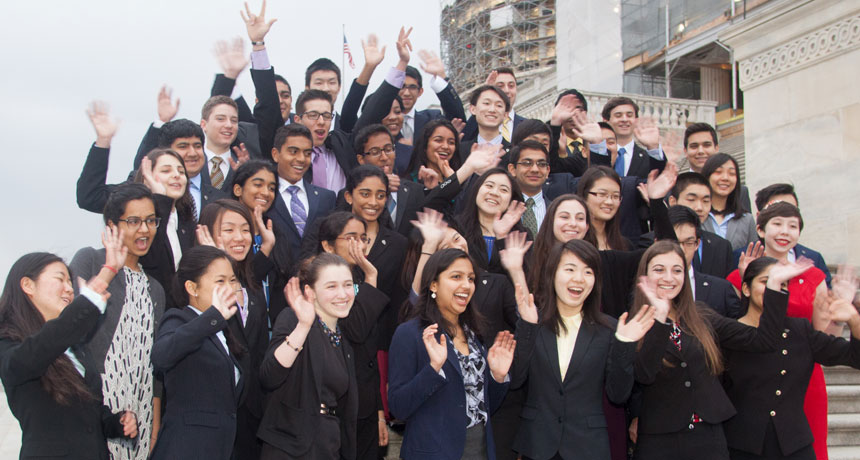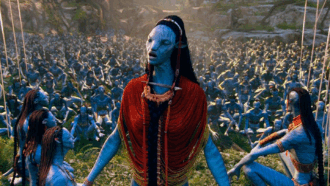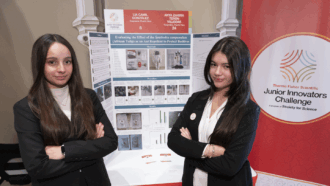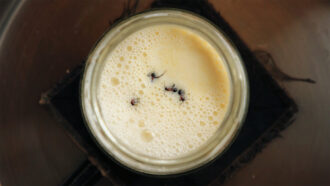The 2016 Intel Scientist Talent Search on Twitter and beyond
Check out the STS Gala, from Twitter to Instagram

The 40 finalists of the Intel Science Talent Search having fun on the steps of Congress.
L. Doane/SSP
Share this:
- Share via email (Opens in new window) Email
- Click to share on Facebook (Opens in new window) Facebook
- Click to share on X (Opens in new window) X
- Click to share on Pinterest (Opens in new window) Pinterest
- Click to share on Reddit (Opens in new window) Reddit
- Share to Google Classroom (Opens in new window) Google Classroom
- Click to print (Opens in new window) Print
WASHINGTON, D.C. — When teens decide to solve problems, great things can happen. One teen made software to spot new targets for drug discovery. One made a device to help people in developing countries diagnose lung problems. A third examined pollutions in streams, and came up with a way to get some of that pollution out. These three high school seniors are the top winners of the 2016 Intel Science Talent Search. They received their $150,000 awards at a gala event March 15 at the National Building Museum.
This year marked the 75th anniversary of the Science Talent Search. Run by Society for Science & the Public and sponsored by Intel, the competition brings together 40 high school seniors to share their research projects with the public and compete for huge prizes. Intel offers three $150,000 awards. Each of the three celebrates an aspect of scientific discovery: basic research, benefits to humankind and innovative technologies.
Eureka! Lab live-tweeted from the gala (follow @eureka_labs), and we have collected the tweets and articles about the finalists below. Congratulations to all 40 finalists for their hard work!
Edit
Intel Science Talent Search Gala 2016
Celebrating 75 years! Run by the Society for Science & the Public, the Intel Science Talent Search brings 40 of the brightest high school students in the country to Washington, D.C. to share their research projects with the public.
-
-
 The view from above! #intelSTS
The view from above! #intelSTS -
-
 Trumpet fanfare! #intelsts #sts75
Trumpet fanfare! #intelsts #sts75 -
-
 Great to meet w/ #IntelSTS finalists today at #NIH. Check out their awesome research: http://bit.ly/1pBrkWB pic.twitter.com/PV67tHx0T2
Great to meet w/ #IntelSTS finalists today at #NIH. Check out their awesome research: http://bit.ly/1pBrkWB pic.twitter.com/PV67tHx0T2 -
-
-
 This bird is not in black tie for the #intelsts #sts75. We should have invited some penguins.
This bird is not in black tie for the #intelsts #sts75. We should have invited some penguins. -
-
-
-
-
-
“We are betting on you to make the world a better place.” – @MayaAjmera to the #IntelSTS #STS75 finalists.
-
-
It’s the first time in the history of competition that women outnumber the men!
-
-
And now, our keynote speaker, @neiltyson!! Famous science guy and head of @HaydenPlanet #IntelSTS #STS75
-
-
.@neiltyson says “the problem isn’t scientifically illiterate children, it’s scientifically illiterate adults” #IntelSTS #STS75
-
“If you maintain curiosity through middle school and high school, you basically become a scientist.” – @neiltyson #IntelSTS #STS75
-
“For many circumstances in life, the answer is not as important as the pathways you explore to get there.” – @neiltyson #IntelSTS #STS75
-
“If you are curious and that’s driving your life? It won’t matter at all what college you go to.” – @neiltyson #IntelSTS #STS75
-
Tyson emphasized that if you do great things, it won’t matter how many prizes you’ve won or where you went to school, your accomplishments will speak for you.
-
Of science @neiltyson says its “more than being about answers, it’s about the questions.” #IntelSTS #STS75
-
And now, the real stars of the evening.
-
-
-
-
-
-
-
Claire Burch hunted exoplanets. She found 17 stars that could have new worlds! #IntelSTS #STS75 http://ow.ly/Zv7yH
-
 Teen hunts exoplanets at our galaxy’s centerWASHINGTON, D.C. – Some scientists look for new planets by gazing through powerful telescopes. But Claire Burch, 17, didn’t have one of those. Instead, the senior at Mira Loma High School in Sacramento, Calif., searched for new exoplanets – planets outside our solar system. All she needed was her laptop and some computer code.
Teen hunts exoplanets at our galaxy’s centerWASHINGTON, D.C. – Some scientists look for new planets by gazing through powerful telescopes. But Claire Burch, 17, didn’t have one of those. Instead, the senior at Mira Loma High School in Sacramento, Calif., searched for new exoplanets – planets outside our solar system. All she needed was her laptop and some computer code. -
-
-
-
 Tiny particles help plastic break down in the sunWASHINGTON, D.C. – Tossing a plastic bag out of a car window isn’t just rude. It creates a huge problem. That’s because when plastic enters the environment, it can take years – if not a century – to go away.
Tiny particles help plastic break down in the sunWASHINGTON, D.C. – Tossing a plastic bag out of a car window isn’t just rude. It creates a huge problem. That’s because when plastic enters the environment, it can take years – if not a century – to go away. -
-
-
-
-
Intel STS 2016: Maria Elena Grimmetthttps://soundcloud.com/scicurious/intel-sts-2016-maria-elena-grimmett
-
-
-
-
-
-
-
-
Intel STS 2016: Milind Jagotahttps://soundcloud.com/scicurious/intel-sts-2016-milind-jagota
-
-
-
-
-
-
-
-
-
-
-
-
Intel STS 2016: Rachel Mashalhttps://soundcloud.com/scicurious/intel-sts-2016-rachel-mashal
-
-
-
-
-
-
-
-
-
Intel STS 2016: Kunal Shroffhttps://soundcloud.com/scicurious/intel-sts-2016-kunal-shroff
-
-
Augusta Uwamanzu-Nna added nanoclay to cement to make it flow better. #IntelSTS #STS75 http://ow.ly/Zvqqw
-
-
 Teen adds tiny bits of clay to make cement go with the flowWASHINGTON, D.C. – Science is all around us, even in the concrete sidewalks under our feet. Most people might not think much about cement. It’s what binds together the rocky components of the concrete used in buildings, bridges and roads. But cement did catch the attention of Augusta Umwamanzu-Nna.
Teen adds tiny bits of clay to make cement go with the flowWASHINGTON, D.C. – Science is all around us, even in the concrete sidewalks under our feet. Most people might not think much about cement. It’s what binds together the rocky components of the concrete used in buildings, bridges and roads. But cement did catch the attention of Augusta Umwamanzu-Nna. -
-
-
 Maya Varma’s spirometer won first place at the #intelsts #sts75
Maya Varma’s spirometer won first place at the #intelsts #sts75 -
-
-
-
-
Rachel Zhang took surfaces from 3D to 2D, she crocheted her results! #IntelSTS #STS75 http://ow.ly/i/hCh2U
-
-
-
-
-
-
-
-
-
-
-
-
-
-
-
-
Now FIRST PLACE, receiving $150,000 each!
-
-
-
-
-
-
 The finalists of the #intelsts #sts75
The finalists of the #intelsts #sts75
%20small%20for%20enews.jpg)

















